1
GATE EE 2003
MCQ (Single Correct Answer)
+1
-0.3
A second order system starts with an initial condition of $$\left( {\matrix{
2 \cr
3 \cr
} } \right)$$ without any external input. The state transition matrix for the system is given by $$\left( {\matrix{
{{e^{ - 2t}}} & 0 \cr
0 & {{e^{ - t}}} \cr
} } \right).$$ The state of the system at the end of $$1$$ second is given by.
2
GATE EE 2003
MCQ (Single Correct Answer)
+2
-0.6
The asymptotic Bode plot of the transfer function $${K \over {1 + {s \over a}}}$$. The error in phase angle and $$dB$$ gain at a frequency of $$\omega = 0.5a$$ are respectively


3
GATE EE 2003
MCQ (Single Correct Answer)
+2
-0.6
The loop gain $$GH$$ of a closed loop system is given by the following expression $${K \over {s\left( {s + 2} \right)\left( {s + 4} \right)}}.$$ The value of $$K$$ for which the system just becomes unstable is
4
GATE EE 2003
MCQ (Single Correct Answer)
+2
-0.6
A control system with certain excitation is governed by the following mathematical equation
$$${{{d^2}x} \over {d{t^2}}} + {1 \over 2}{{dx} \over {dt}} + {1 \over {18}}x = 10 + 5{e^{ - 4t}} + 2{e^{ - 5t}}$$$
The natural time constants of the response of the system are
The natural time constants of the response of the system are
Paper analysis
Total Questions
Analog Electronics
8
Control Systems
10
Digital Electronics
5
Electric Circuits
10
Electrical and Electronics Measurement
10
Electrical Machines
14
Electromagnetic Fields
4
Power Electronics
7
Power System Analysis
17
More papers of GATE EE
GATE EE 2025
GATE EE 2024
GATE EE 2023
GATE EE 2022
GATE EE 2021
GATE EE 2020
GATE EE 2019
GATE EE 2018
GATE EE 2017 Set 1
GATE EE 2017 Set 2
GATE EE 2016 Set 2
GATE EE 2016 Set 1
GATE EE 2015 Set 1
GATE EE 2015 Set 2
GATE EE 2014 Set 3
GATE EE 2014 Set 2
GATE EE 2014 Set 1
GATE EE 2013
GATE EE 2012
GATE EE 2011
GATE EE 2010
GATE EE 2009
GATE EE 2008
GATE EE 2007
GATE EE 2006
GATE EE 2005
GATE EE 2004
GATE EE 2003
GATE EE 2002
GATE EE 2001
GATE EE 2000
GATE EE 1999
GATE EE 1998
GATE EE 1997
GATE EE 1996
GATE EE 1995
GATE EE 1994
GATE EE 1993
GATE EE 1992
GATE EE 1991
GATE EE
Papers
2025
2024
2023
2022
2021
2020
2019
2018
2013
2012
2011
2010
2009
2008
2007
2006
2005
2004
2003
2002
2001
2000
1999
1998
1997
1996
1995
1994
1993
1992
1991